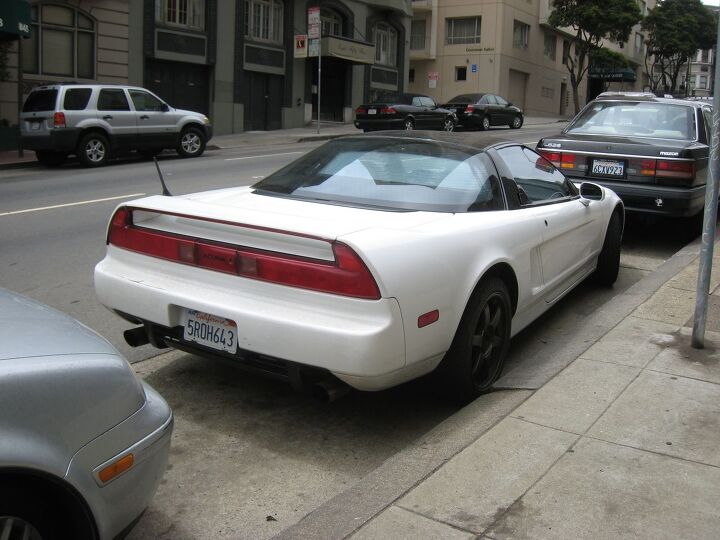Down On The Street: 1992 Acura NSX Braves Streets of San Francisco

Every time I see an early NSX— which, sadly, isn’t often— it reinforces my belief that the early 1990s were a golden age for the automobile. You had decent electronic engine controls instead of carburetors (and primitive might-as-well-be-carburetors 80s EFI), model bloat hadn’t gotten totally out of hand, and the SUV revolution hadn’t yet caused cup holders and other McMansion-esque gear to metastasize from every interior surface of every vehicle. Sure, we’re now living in the Golden Age Of Engines— there’s no arguing with the horsepower and efficiency numbers we’re seeing from internal combustion these days— but I’ll take the early 1990s. And the NSX.
I shot this car in San Francisco a couple of years back, while in transit to the nightmarish Gumball 3000 kickoff, and I was reminded of the photos when I spotted a black mid-90s NSX cruising through the snow in Denver earlier this week.
While the Miata’s “like an MGB, only you can actually drive the thing” concept inspired legions of worshipers, the NSX never really inspired the same sort of passion among North American car freaks (even given the $65,000-versus-$13,400 price tag comparison in 1992).
Speaking of price tags, the ‘3,010-pound/270-horsepower ’92 NSX listed at about a grand more than the 3,031-pound/250-horsepower ’92 Porsche 911 Carrera 2 coupe. You could also get a ’92 ZR1 Corvette for a few hundred bucks more than the NSX, which would have given you a mighty 375 horses in a 3,465-pound machine; sure, the build quality might not have been in the same universe as the Acura or the Porsche, but what a deal! Say you were time-machined back to 1992 with a suitcase full of cash and had to choose, which would it be: the NSX, 911, or ZR1?

Murilee Martin is the pen name of Phil Greden, a writer who has lived in Minnesota, California, Georgia and (now) Colorado. He has toiled at copywriting, technical writing, junkmail writing, fiction writing and now automotive writing. He has owned many terrible vehicles and some good ones. He spends a great deal of time in self-service junkyards. These days, he writes for publications including Autoweek, Autoblog, Hagerty, The Truth About Cars and Capital One.
More by Murilee Martin
Latest Car Reviews
Read moreLatest Product Reviews
Read moreRecent Comments
- GrumpyOldMan All modern road vehicles have tachometers in RPM X 1000. I've often wondered if that is a nanny-state regulation to prevent drivers from confusing it with the speedometer. If so, the Ford retro gauges would appear to be illegal.
- Theflyersfan Matthew...read my mind. Those old Probe digital gauges were the best 80s digital gauges out there! (Maybe the first C4 Corvettes would match it...and then the strange Subaru XT ones - OK, the 80s had some interesting digital clusters!) I understand the "why simulate real gauges instead of installing real ones?" argument and it makes sense. On the other hand, with the total onslaught of driver's aid and information now, these screens make sense as all of that info isn't crammed into a small digital cluster between the speedo and tach. If only automakers found a way to get over the fallen over Monolith stuck on the dash design motif. Ultra low effort there guys. And I would have loved to have seen a retro-Mustang, especially Fox body, have an engine that could rev out to 8,000 rpms! You'd likely be picking out metal fragments from pretty much everywhere all weekend long.
- Analoggrotto What the hell kind of news is this?
- MaintenanceCosts Also reminiscent of the S197 cluster.I'd rather have some original new designs than retro ones, though.
- Fahrvergnugen That is SO lame. Now if they were willing to split the upmarketing price, different story.



















































Comments
Join the conversation
I would definitely buy the NSX: world class handling, insane horsepower from a V6 NA mid-ship-mounted automobile, and it looked like nothing else on the road for a 2-seater from a Japan. I always thought Porcshe owners were tools and ZR-1 owners were just pompous assholes (kinda like some Mustang GT owners I knew at the time). American "muscle" had lapsed into coma by that time, and paying 97k for a Corvette was unheard of. R&T had a review of the car, and I remember reading that while straight-line performance was impressive, skid-pad performance was lack-luster and the car was in much need of a suspension upgrade to be able to handle corners. I'd get it in the Grand Prix White that they had for a number of years (much like the photo) or the Silver that was on the original prototype (Best Motoring had a test drive in 1989 and I still have the video tape of it). That was, and will always be, an amazing sports car.
Is that NSX parked in front of the Dungeon?